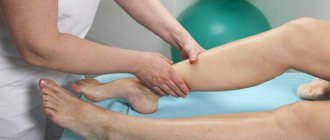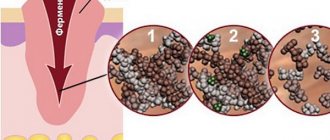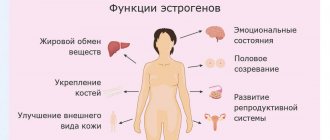Pharmacological properties of the drug Ketoprofen
NSAIDs of the group of propionic acid derivatives. It has a pronounced anti-inflammatory, analgesic and antipyretic effect. Pharmacological effects are due to the ability to disrupt the synthesis of prostaglandins by inhibiting COX activity. Ketoprofen also inhibits the synthesis of leukotrienes, bradykinin activity, and stabilizes lysosomal membranes. In case of articular syndrome, it reduces the severity of arthralgia (at rest and during movement), morning stiffness and swelling of the joints, and helps reduce the degree of their functional insufficiency. Ketoprofen does not have a catabolic effect on cartilage tissue, and at concentrations of 10-4 mol/l it is able to stimulate the synthesis of proteoglycan in cells of immature human cartilage. Antipyretic activity is due to the effect on the thermoregulation center in the hypothalamus. Inhibits platelet aggregation. It is quickly and almost completely absorbed from the digestive tract after oral administration. Simultaneous administration with food or milk slows down absorption, but does not reduce its volume. Bioavailability - approximately 90%, maximum concentration in blood plasma is achieved after 1-2 hours; half-life is 1.1–4 hours (may increase in elderly people and with severe renal failure). With rectal administration, the maximum concentration in the blood plasma is achieved after 4 hours, and with intramuscular administration - after 15–45 minutes. After using retard tablets, the effective concentration is achieved within 45–60 minutes. The therapeutic concentration of ketoprofen lasts longer in synovial fluid than in the blood. Up to 99% of ketoprofen binds to blood plasma proteins. Metabolized in the liver, mainly by conjugation with glucuronic acid. Excreted in urine, mainly in the form of metabolites; Less than 1% of ketoprofen is excreted unchanged. About 1–8% is excreted in the feces.
Ketoprofen gel
Dosage form
Gel for external use
Composition per 100 g:
Active substance
: ketoprofen – 2.5 g.
Excipients
: carbomer – 1.5 g, alcohol 95% – 32.0 g, trolamine – 2.9 g, lavender oil – 0.1 g, purified water – up to 100.0 g.
Description
Colorless, transparent or opalescent gel with a characteristic odor.
Pharmacotherapeutic group
Non-steroidal anti-inflammatory drug (NSAID).
ATX code: M02AA10.
Pharmacological properties
Pharmacodynamics
Ketoprofen is one of the most effective cyclooxygenase inhibitors. It also inhibits lipoxygenase and bradykinin activity. Stabilizes lysosomal membranes and prevents the release of enzymes involved in the inflammatory process. The main properties of ketoprofen are analgesic, anti-inflammatory and anti-edema effects. Ketoprofen does not have a negative effect on the condition of articular cartilage.
Pharmacokinetics
Ketoprofen, when applied topically in the form of a gel, does not accumulate in the body. The bioavailability of the gel is about 5%. The maximum concentration of ketoprofen in the blood plasma is achieved 6 hours after application of the drug. Penetrates into joint tissues, incl. into the synovial fluid, and reaches therapeutic concentrations there. The concentration of the drug in the blood plasma is extremely low.
Ketoprofen is metabolized in the liver to form conjugates, which are excreted primarily by the kidneys. The metabolism of ketoprofen does not depend on age, the presence of severe renal failure or liver cirrhosis. Excretion of ketoprofen by the kidneys is slow.
Indications for use
Symptomatic therapy – reduction of pain and inflammation at the time of use, does not affect the progression of the disease – in the following conditions:
• reactive arthritis (Reiter's syndrome);
• osteoarthritis of various localizations;
• periarthritis, tendinitis, bursitis, myalgia, neuralgia, radiculitis;
• injuries of the musculoskeletal system (including sports), bruises of muscles and ligaments, sprains, ruptures of ligaments and tendons.
Contraindications
• Hypersensitivity to ketoprofen or other components of the drug, as well as to salicylates, tiaprofenic acid or other NSAIDs, fenofibrate; history of skin allergies to sunscreens and perfumes;
• complete or incomplete combination of bronchial asthma, recurrent polyposis of the nose and paranasal sinuses and intolerance to acetylsalicylic acid or other NSAIDs (including a history);
• III trimester of pregnancy;
• children's age (up to 15 years);
• violation of the integrity of the skin in the area where the gel is applied (eczema, acne, weeping dermatitis, open or infected wound);
• history of photosensitivity reactions;
• exposure to sunlight, incl. indirect sunlight and UV irradiation in a solarium throughout the entire treatment period and for another 2 weeks after stopping treatment with the drug.
Carefully
You should consult your doctor before using Ketoprofen gel if you have:
• impaired liver and/or kidney function;
• erosive and ulcerative lesions of the gastrointestinal tract; • blood diseases;
• bronchial asthma;
• chronic heart failure;
• hepatic porphyria (exacerbation).
Use during pregnancy and breastfeeding
Pregnancy
Use in
the 1st and 2nd trimesters of pregnancy
Since the safety of ketoprofen in pregnant women has not been assessed, the use of ketoprofen should be avoided in the 1st and 2nd trimesters of pregnancy.
Use in the third trimester of pregnancy
The drug Ketoprofen gel is contraindicated in the third trimester of pregnancy.
During the third trimester of pregnancy, all prostaglandin synthetase inhibitors, including ketoprofen, can have a toxic effect on the heart, lungs and kidneys of the fetus. At the end of pregnancy, bleeding time in the mother and child may increase. NSAIDs may delay the onset of labor.
Breast-feeding
To date, there is no data on the release of ketoprofen into breast milk, therefore the use of the drug Ketoprofen gel during breastfeeding is not recommended.
Directions for use and doses
For external use.
A small amount of gel (3-5 cm) is applied in a thin layer to the skin of the inflamed or painful area of the body 1-2 times a day and rubbed in gently.
The dosage should be selected in accordance with the area of the affected area: 5 cm of Ketoprofen gel corresponds to 100 mg of ketoprofen, 10 cm corresponds to 200 mg of ketoprofen.
If necessary, Ketoprofen gel can be combined with other dosage forms of the drug Ketoprofen (capsules, tablets, rectal suppositories, solution for intramuscular administration).
The maximum dose of ketoprofen is 200 mg/day.
Occlusive dressing is not recommended.
Do not use without consulting a doctor for more than 14 days.
If you forget to apply the gel, apply it at the time the next dose is due, but do not double it.
Side effect
According to the World Health Organization (WHO), adverse effects are classified according to their frequency as follows: very common (> 1/10), common (> 1/100 to < 1/10), uncommon (> 1/1000 to <1/100), rare (from >1/10000 to <1/1000), very rare (<1/10000); frequency unknown - based on available data, it was not possible to determine the frequency of occurrence.
Immune system disorders
frequency unknown: anaphylactic shock, angioedema (Quincke's edema), hypersensitivity reactions.
Gastrointestinal disorders
very rarely: peptic ulcer, bleeding, diarrhea.
Skin and subcutaneous tissue disorders
uncommon: local skin reactions such as erythema, eczema, itching and burning;
rarely: photosensitivity reactions, urticaria.
There have been rare reports of more severe reactions, such as bullous or phlyctenulous eczema, which may spread beyond the site of application or become generalized.
Renal and urinary tract disorders
very rare: deterioration of renal function in patients with chronic renal failure.
If any side effects occur, you should stop using the drug and consult a doctor.
Overdose
Overdose is unlikely when the drug is used externally.
In case of overdose, the skin should be thoroughly rinsed under running water.
If the drug is ingested, systemic adverse reactions may develop. In this case, symptomatic treatment and supportive therapy are necessary, as in case of overdose with oral forms.
Interaction with other drugs
When ketoprofen is used externally in a gel dosage form, it is possible to enhance the effect of drugs that cause photosensitivity.
Patients taking coumarin anticoagulants are recommended to regularly monitor the international normalized ratio (INR).
Ketoprofen, like other NSAIDs, may reduce the elimination of methotrexate and increase its toxicity.
Interaction with other drugs and the effect on their elimination are not significant.
special instructions
It is necessary to avoid getting the gel in the eyes, on the skin around the eyes, and mucous membranes. If skin reactions occur, including those that develop during combined use with octocrylene-containing drugs, treatment should be stopped immediately.
Patients suffering from bronchial asthma in combination with chronic rhinitis, chronic sinusitis and/or polyposis of the nose or paranasal sinuses have a higher risk of developing allergic reactions when using aspirin and/or NSAIDs than the rest of the population.
To reduce the risk of developing photosensitivity, it is recommended to protect the skin areas treated with the gel with clothing from exposure to UV radiation throughout the entire treatment period and for another 2 weeks after stopping use. The recommended duration of treatment should not be exceeded due to the increased risk of developing contact dermatitis and photosensitivity reactions over time. You should wash your hands thoroughly after each application of the drug.
The effect of the drug on the ability to drive vehicles and machinery
There is no data on the negative effect of Ketoprofen gel on the ability to drive vehicles and engage in other potentially hazardous activities that require concentration and speed of psychomotor reactions.
Release form
Gel for external use 2.5%.
10, 15, 20, 25, 30, 40, 50, 60, 70, 80, 90, 100 g in aluminum tubes with high-density polyethylene caps or in polymer tubes with polyethylene screw caps.
Each tube, along with instructions for medical use, is placed in a cardboard pack.
Storage conditions
At a temperature not higher than 25 °C.
Keep out of the reach of children.
Best before date
3 years.
Do not use after the expiration date stated on the packaging.
Vacation conditions
Available without a prescription.
Use of the drug Ketoprofen
Externally, internally, rectally, intramuscularly or intravenously. Orally - during or after meals, 200–300 mg/day in 2–3 divided doses or 1 retard tablet 1–2 times a day. IM - 100 mg 1-2 times a day. Ketoprofen infusions are carried out only in a hospital setting. The average infusion time is 30 minutes - 1 hour, the maximum is no more than 48 hours, and the dose of ketoprofen should not exceed 300 mg. For short-term infusion, 100–200 mg of ketoprofen is dissolved in 100 ml of isotonic sodium chloride solution and administered over 30 minutes to 1 hour; the interval between injections is 8 hours. For long-term infusion, 100–200 mg of ketoprofen is dissolved in 500 ml of infusion solution (isotonic sodium chloride solution, Ringer's solution, glucose solution) and administered for 8 hours; the interval between administrations is 8 hours. Ketoprofen can be used in combination with centrally acting analgesics. For combined use, ketoprofen is mixed with morphine in one bottle (100–200 mg of ketoprofen and 10–20 mg of morphine), dissolved in 500 ml of isotonic sodium chloride solution or Ringer’s solution and administered every 8 hours. If necessary, treatment can be continued by prescribing ketoprofen orally or rectally in the form of suppositories. The cream or gel is applied to the skin of the affected area 3-4 times a day.
Side effects of the drug Ketoprofen
Dyspepsia (12% of cases), nausea/vomiting, abdominal pain, heartburn, diarrhea, constipation, flatulence (3–9%), gastritis, hemorrhoidal bleeding, peptic ulcer, upper gastrointestinal bleeding, intestinal perforation (less than in 1% of cases), urticaria, maculopapular rash (1–3%), purpura, bullous rash, erythema multiforme, exfoliative dermatitis, Stevens-Johnson syndrome, toxic epidermal necrolysis, photosensitivity (extremely rare), headache, dizziness, drowsiness, insomnia, depression, increased excitability (1–3%), peripheral edema (2%), worsening of congestive heart failure and peripheral vascular disease (less than 1%), hemorrhages and retinal pigmentation (less than 1%), jaundice, hepatitis, cholestatic hepatitis (less than 1%), increased activity of liver enzymes (15%), hematuria, proteinuria, papillary necrosis, interstitial nephritis, nephrotic syndrome (extremely rare).
Instructions for use KETOPROFEN-LF
Avoid using the drug in combination with other NSAIDs, incl. with selective COX-2 inhibitors.
The severity of side effects can be reduced by using the minimum effective dose for the minimum time required to improve the condition.
Elderly patients are more likely to experience adverse reactions to NSAIDs, especially GI bleeding and perforation, which can be life-threatening.
Gastrointestinal bleeding, ulcer formation or perforation, in some cases with fatal outcome, have been reported for all NSAIDs at various stages of treatment, regardless of the presence of warning symptoms or a history of serious gastrointestinal pathology. According to epidemiological data, the use of ketoprofen may be associated with a high risk of severe gastrointestinal toxicity, which is typical for some other NSAIDs, especially when taken in high doses.
The risk of gastrointestinal bleeding, ulcer formation or perforation increases with increasing doses of NSAIDs in patients with a history of ulcers, especially those complicated by bleeding or perforation, as well as in elderly patients. In this case, treatment begins with a minimum dose. For these patients, as well as for patients taking low doses of acetylsalicylic acid or other drugs that increase the risk of gastrointestinal complications, combination therapy with protective drugs, such as misoprostol or proton pump inhibitors, should be considered. Patients with a history of gastrointestinal toxicity, especially elderly patients, should report any unusual symptoms to the physician, especially during the initial stages of treatment. The drug should be prescribed with extreme caution to patients concomitantly receiving medications that may increase the risk of ulcers or bleeding:
- oral corticosteroids, anticoagulants (eg, warfarin), selective serotonin reuptake inhibitors, or antiplatelet agents such as aspirin.
If gastrointestinal bleeding develops, use of the drug should be discontinued. NSAIDs are prescribed with caution to patients with a history of gastrointestinal diseases (ulcerative colitis, Crohn's disease), because Exacerbations of these diseases may occur. The relative risk of developing gastrointestinal bleeding increases in patients with low body weight; if bleeding develops, treatment should be discontinued immediately.
Patients with hypertension and/or mild to moderate congestive heart failure require appropriate monitoring and counseling as fluid retention and edema have been reported with the use of NSAIDs. According to the results of clinical studies and epidemiological data, the use of some NSAIDs, especially in high doses and for a long time, may be accompanied by an increased risk of arterial thrombosis, such as myocardial infarction or stroke. There is insufficient data to exclude such a danger when using ketoprofen.
Patients with bronchial asthma in combination with chronic allergic rhinitis, chronic allergic sinusitis and/or nasal polyps are at high risk of allergy to aspirin and/or NSAIDs. The use of ketoprofen may cause asthma attacks or bronchospasm, especially in patients with an allergy to aspirin or NSAIDs.
It is necessary to monitor renal function at the beginning of treatment in patients with heart failure, cirrhosis and impaired liver function, especially in patients receiving diuretics, patients with chronic renal failure, especially in elderly patients. In these patients, ketoprofen may cause a decrease in renal blood flow by inhibiting prostaglandins and lead to renal failure.
In patients with impaired liver function, the activity of hepatic transaminases should be regularly assessed, especially during long-term therapy. Treatment should be discontinued if visual disturbances such as blurred vision occur. Prescribe with caution to persons suffering from alcohol dependence.
Extremely rare cases of the development of serious skin reactions (some with fatal outcomes) have been described due to the use of NSAIDs, incl. exfoliative dermatitis, Stevens-Johnson syndrome and toxic epidermal necrolysis. Patients are at greatest risk in the first month of treatment. If a skin rash, signs of damage to the mucous membranes or other symptoms of hypersensitivity appear, the drug should be discontinued.
With prolonged treatment, it is necessary to monitor the number of blood cells, as well as liver and kidney function.
Like other NSAIDs, ketoprofen, due to its anti-inflammatory, antipyretic or analgesic effect, can mask symptoms of infection progression, such as increased body temperature.
Before major surgery, the drug must be discontinued. In case of hyperkalemia due to diabetes mellitus or concomitant therapy with potassium-sparing drugs, it is necessary to regularly monitor potassium levels.
For severe pain, ketoprofen can be used in combination with morphine.
Therapy with the injectable form of ketoprofen should be carried out under close medical supervision. When eliminating acute pain, it is advisable to switch to other dosage forms that are less likely to cause serious adverse reactions. IM administration for a long time is recommended to be carried out in a hospital under the supervision of a physician.
Excipients
The solution contains about 8% ethanol by volume, i.e. up to 197.2 mg/ampule of ethanol, which corresponds to 4 ml of beer or 1.6 ml of wine. The drug may have a negative effect on persons suffering from alcoholism. The ethanol content should be taken into account when prescribing the drug during pregnancy and lactation, children and patients at risk, for example, with liver diseases, as well as those suffering from epilepsy.
Propylene glycol in doses of 400 mg/kg for adults may cause symptoms similar to those caused by alcohol consumption.
The drug contains sodium in an amount of less than 1 mmol/ampoule and is therefore considered sodium-free.
Use in pediatrics
Use in children is contraindicated.
Due to the benzyl alcohol content, the drug should not be administered to premature infants or newborns; benzyl alcohol can cause toxic and anaphylactoid reactions in children under 3 years of age.
Propylene glycol at a dose of 200 mg/kg in children can cause symptoms similar to those caused by alcohol consumption.
Impact on the ability to drive vehicles and operate machinery
Patients should be warned that this drug may cause drowsiness, dizziness, or seizures and advised not to drive or operate machinery if these symptoms occur.
Patients should be warned about the possible occurrence of visual impairment. In this case, you should not drive vehicles or operate machinery.
Drug interactions Ketoprofen
To avoid the formation of sediment, do not mix ketoprofen and tramadol solutions in one bottle. The frequency of side effects from the digestive tract, primarily hemorrhagic, increases when ketoprofen is taken simultaneously with other NSAIDs, ethanol, indirect anticoagulants, and corticosteroids. Preparations of garlic, onion, and ginkgo biloba potentiate the antiplatelet effect of ketoprofen and may increase the risk of developing hemorrhagic complications. When administered concomitantly with cidofovir, potentiation of nephrotoxicity is possible; ketoconazole should be discontinued at least 7 days before cidofovir is prescribed. Co-administration with probenecid may increase the concentration of ketoprofen in the blood plasma. The concentration of lithium and its toxic effects may increase when used simultaneously with ketoprofen, so they should be monitored. The simultaneous administration of ketoprofen and digoxin may cause an increase in the concentration of the latter in the blood plasma, especially in patients with renal failure. Ketoprofen inhibits the synthesis of prostaglandins in the kidneys and may potentiate the nephrotoxicity of cyclosporine. When used simultaneously with ketoprofen, the clearance of methotrexate may be reduced. Ketoprofen helps reduce the diuretic, natriuretic and antihypertensive effect of diuretics; simultaneous use of potassium-sparing agents (triamterene, spironolactone) can cause the development of hyperkalemia. Ketoprofen can reduce the effectiveness of antihypertensive drugs (beta-adrenergic receptor blockers, ACE inhibitors) due to disruption of the synthesis of prostaglandins in the kidneys. When used simultaneously with alendronate, the risk of developing gastropathy increases significantly.
List of pharmacies where you can buy Ketoprofen:
- Moscow
- Saint Petersburg




